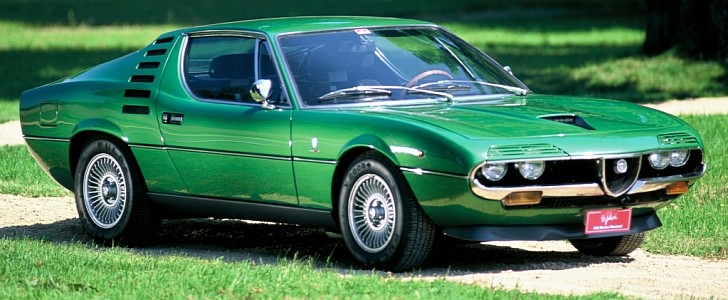Marcello Gandini penned iconic automobiles that include the Lamborghini Miura, Countach, E12 BMW 5 Series, Dino 308 GT4, Lancia Stratos, and Renault 5 Turbo. The Italian designer is also responsible for the Alfa Romeo Montreal, one of the most underappreciated coupes out there.
The story of the Montreal begins in… wait for it… Montreal. Two prototypes were presented at the Expo 67, white-painted cars that featured the 1.6-liter “Bialbero” engine of the Giulia TI and the short-wheelbase chassis of the Giulia Sprint GT. One concept is displayed at Museo Storico Alfa Romeo.
In addition to the four-cylinder powerplant, these prototypes also differ from the production model in terms of exterior design. The most obvious divergence comes in the guise of headlight grilles. More specifically, they’re fixed on the white-painted concepts and retractable on the real deal.
Internally referred to as Tipo 105.64, the series-production Montreal bears this codename because it features a modified floorpan and various suspension componentry from the Alfa Romeo 105 series of coupes and cabriolets.
The Italian automaker took the veils off the production-ready car in 1970 at the Geneva Motor Show, and many people were understandably impressed by the switch to a double-overhead V8 engine derived from the 2.0-liter unit of the glorious Tipo 33. Enlarged to 2.6 liters, the dry-sump powerplant boasts a cross-plane crankshaft like the venerable Chevrolet small-block V8.
But as opposed to what Chevrolet was doing with the small-block engine in the early ‘70s, the Montreal received mechanical fuel injection from SPICA. Founded in 1932, Societa Pompe Iniezione Cassani & Affini was purchased by Alfa Romeo in 1941, then it was acquired by Fiat, Delphi, and TRW.
The all-alloy lump sweetens the deal with a compression ratio of 9.0:1 and Bosch-supplied electronic ignition. When it was brand-spanking new, the DOHC engine cranked out 197 horsepower (200 PS) at 6,500 revolutions per minute and 173 pound-feet (235 Nm) at 4,750 revolutions per minute.
Capable of 224 kilometers per hour (139 miles per hour) on full song and 7.1 seconds to 100 kilometers per hour (62 miles per hour), the quad-cam V8 is complemented by a five-speed manual transmission supplied by ZF Friedrichshafen. The row-your-own box is connected to a self-locking differential (the ZF SD DL 175), and the rear end is a simple live axle.
Trailing arms, coaxial dampers, and coil springs help the Montreal handle like a charm in the twisties. Up front, Alfa Romeo fitted double wishbones inspired by the Tipo 33 mentioned earlier. Both ends rock anti-roll bars, and stopping power comes courtesy of power-assisted disc brakes all around.
To whom it may concern, the NACA duct on the hood is a dummy whose only purpose is to conceal the power bulge. Reminiscent of the Lamborghini Miura, the upswept doors and side windows are joined by C-pillar slatted air vents inspired by Giorgetto Giugiaro’s dazzling Alfa Romeo Canguro.
Available with leather upholstery, the Montreal came standard with fabric seats augmented by Texalfa synthetic leatherette on the sides and backs. Optional extras also included A/C, electric windows, and electric mirrors.
Tipping the scales at 1,270 kilograms (2,800 pounds), the 2+2 coupe doesn’t offer enough rear-passenger legroom due to its 2,350-mm wheelbase. The Hyundai Kona subcompact utility vehicle, by comparison, has 2,600 mm.
Manufactured in Arese, the rolling chassis of the Montreal was delivered to Castelle where Bertone fitted the body shell. The Italian coachbuilder then shipped these cars to Grugliasco for rustproofing, painting, and interior fitting. After so much logistical effort, Alfa Romeo shipped the Montreal back to Arese to install the oily bits, including that stupendous V8 engine.
Given these circumstances, the Montreal was properly expensive by 1970 standards. 5,700,000 lire for the base model translates to roughly $8,990 based on an exchange rate of 634 lire per U.S. dollar. Adjusted for inflation, that’s $64,400 today, the kind of money that gets you a C8 Corvette.
According to FCA Heritage, precisely 3,925 units were manufactured between 1970 and 1977. Like many underrated classics from that era, the Montreal flopped due to its relatively high price and the OPEC oil crisis. What's more, emission regulations denied the Montreal access to the U.S. market.
Despite its rarity, the Montreal can be had for cheap nowadays. Recent auction listings price well-maintained cars between 50,000 and 80,000 euros or $56,805 to $90,888 at current exchange rates. By comparison, a base BMW 5er starts at 51,500 euros ($58,510) back home in Germany.
In addition to the four-cylinder powerplant, these prototypes also differ from the production model in terms of exterior design. The most obvious divergence comes in the guise of headlight grilles. More specifically, they’re fixed on the white-painted concepts and retractable on the real deal.
Internally referred to as Tipo 105.64, the series-production Montreal bears this codename because it features a modified floorpan and various suspension componentry from the Alfa Romeo 105 series of coupes and cabriolets.
The Italian automaker took the veils off the production-ready car in 1970 at the Geneva Motor Show, and many people were understandably impressed by the switch to a double-overhead V8 engine derived from the 2.0-liter unit of the glorious Tipo 33. Enlarged to 2.6 liters, the dry-sump powerplant boasts a cross-plane crankshaft like the venerable Chevrolet small-block V8.
But as opposed to what Chevrolet was doing with the small-block engine in the early ‘70s, the Montreal received mechanical fuel injection from SPICA. Founded in 1932, Societa Pompe Iniezione Cassani & Affini was purchased by Alfa Romeo in 1941, then it was acquired by Fiat, Delphi, and TRW.
The all-alloy lump sweetens the deal with a compression ratio of 9.0:1 and Bosch-supplied electronic ignition. When it was brand-spanking new, the DOHC engine cranked out 197 horsepower (200 PS) at 6,500 revolutions per minute and 173 pound-feet (235 Nm) at 4,750 revolutions per minute.
Capable of 224 kilometers per hour (139 miles per hour) on full song and 7.1 seconds to 100 kilometers per hour (62 miles per hour), the quad-cam V8 is complemented by a five-speed manual transmission supplied by ZF Friedrichshafen. The row-your-own box is connected to a self-locking differential (the ZF SD DL 175), and the rear end is a simple live axle.
To whom it may concern, the NACA duct on the hood is a dummy whose only purpose is to conceal the power bulge. Reminiscent of the Lamborghini Miura, the upswept doors and side windows are joined by C-pillar slatted air vents inspired by Giorgetto Giugiaro’s dazzling Alfa Romeo Canguro.
Available with leather upholstery, the Montreal came standard with fabric seats augmented by Texalfa synthetic leatherette on the sides and backs. Optional extras also included A/C, electric windows, and electric mirrors.
Tipping the scales at 1,270 kilograms (2,800 pounds), the 2+2 coupe doesn’t offer enough rear-passenger legroom due to its 2,350-mm wheelbase. The Hyundai Kona subcompact utility vehicle, by comparison, has 2,600 mm.
Manufactured in Arese, the rolling chassis of the Montreal was delivered to Castelle where Bertone fitted the body shell. The Italian coachbuilder then shipped these cars to Grugliasco for rustproofing, painting, and interior fitting. After so much logistical effort, Alfa Romeo shipped the Montreal back to Arese to install the oily bits, including that stupendous V8 engine.
Given these circumstances, the Montreal was properly expensive by 1970 standards. 5,700,000 lire for the base model translates to roughly $8,990 based on an exchange rate of 634 lire per U.S. dollar. Adjusted for inflation, that’s $64,400 today, the kind of money that gets you a C8 Corvette.
According to FCA Heritage, precisely 3,925 units were manufactured between 1970 and 1977. Like many underrated classics from that era, the Montreal flopped due to its relatively high price and the OPEC oil crisis. What's more, emission regulations denied the Montreal access to the U.S. market.
Despite its rarity, the Montreal can be had for cheap nowadays. Recent auction listings price well-maintained cars between 50,000 and 80,000 euros or $56,805 to $90,888 at current exchange rates. By comparison, a base BMW 5er starts at 51,500 euros ($58,510) back home in Germany.




















